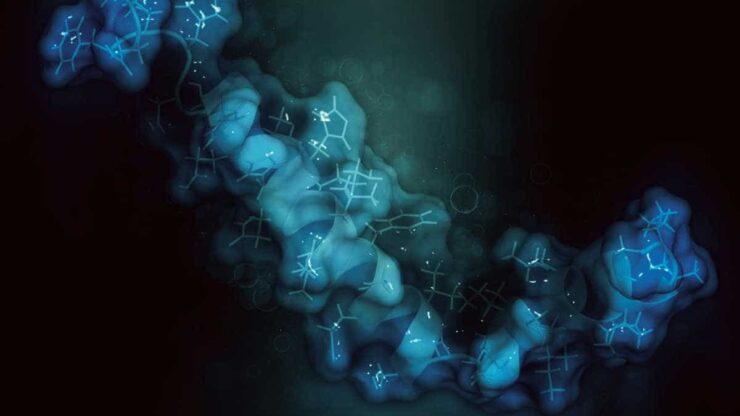In a mouse model of Alzheimer’s disease, researchers at the University of Pennsylvania’s Perelman School of Medicine found that a “chaperone” molecule that inhibits the production of specific proteins reversed disease signs, including memory impairment.
The researchers investigated the effects of 4-phenylbutyrate (PBA), a fatty acid molecule known to act as a “chemical chaperone” that limits protein accumulation. Giving the animals PBA injections helped restore signs of normal proteostasis (the process of controlling proteins) in their brains. These injections also greatly improved their performance on a standard memory test, even when given late in the disease’s progression.
“By generally improving neuronal and cellular health, we can mitigate or delay disease progression. In addition, reducing proteotoxicity — irreparable damage to the cell that is caused by an accumulation of impaired and misfolded proteins — can help improve some previously lost brain functions,”
said senior author Nirinjini Naidoo, Ph.D., a research associate professor of sleep medicine at the University of Pennsylvania School of Medicine.
Normalized Proteostasis
Alzheimer’s disease affects more than 6 million Americans, and up to 13.8 million could be diagnosed by 2060 if no medical advances to delay or cure the illness are made. Alzheimer’s disease, like other neurodegenerative illnesses, is characterized by the formation of protein aggregates in the brain, as well as the disruption of proteostasis.

Previously, researchers found that the treatment with 4-phenylbutyrate improved sleep quality and cognitive test performance, and helped normalize proteostasis, in mice that model ordinary human brain aging. For the new study, they investigated PBA’s effects in mice that model Alzheimer’s disease.
Similar to people suffering from Alzheimer’s disease, these mice, referred to as APPNL-G-F mice, experience severe memory impairment, loss of many synapses connecting brain cells, and abnormal protein aggregate accumulation in their brains.
Early Life and Middle-age Treatments
First, the team showed that these mice do indeed have signs of dysfunctional proteostasis mechanisms — including a chronically activated process called the unfolded protein response — and relatively low levels of a natural aggregate-preventing “chaperone” protein called binding immunoglobulin protein (BiP) or Hspa5.
After administering PBA to the mice, graduate student Jennifer Hafycz discovered that the drug assisted in restoring signs of typical proteostasis in crucial memory-related brain regions. The medication also restored the mice’s capacity to discern between moved and immobile items on a typical memory test known as the Spatial Object Recognition test, which had previously been lost.
The team found that they could achieve similar effects, including the reversal of memory deficits, even when they treated the mice starting in middle age.
Both early life and middle-age treatment showed symptoms of suppressing the process that produces the most visible protein aggregation in Alzheimer’s disease, known as amyloid beta plaques. The latter treatment lowered not just the underlying mechanism but also the quantity of amyloid plaques.
PBA has the advantage of being an easy bloodstream-to-brain transfer agent and having already received FDA approval for treating a different metabolic disorder, making it a promising treatment option for Alzheimer’s sufferers.
Abstract
Alzheimer’s disease (AD) is a debilitating neurodegenerative disorder that is pervasive among the aging population. Two distinct phenotypes of AD are deficits in cognition and proteostasis, including chronic activation of the unfolded protein response (UPR) and aberrant Aβ production. It is unknown if restoring proteostasis by reducing chronic and aberrant UPR activation in AD can improve pathology and cognition. Here, we present data using an amyloid precursor protein knock-in mouse model of AD and several protein chaperone supplementation paradigms, including a late-stage intervention. We show that supplementing protein chaperones systemically and locally in the hippocampus reduces PERK signaling and increases XBP1s, which is associated with increased ADAM10 and decreased Aβ42. Importantly, chaperone treatment improves cognition, which is correlated with increased CREB phosphorylation and BDNF. Together, these data suggest that chaperone treatment restores proteostasis in a mouse model of AD and that this restoration is associated with improved cognition and reduced pathology.
Reference:
- Jennifer M. Hafycz, Ewa Strus, Kamalini Sengupta, and Nirinjini Naidoo. Early and Late Chaperone Intervention Therapy Boosts XBP1s and ADAM10, Restores Proteostasis, and Rescues Learning in Alzheimer’s Disease Mice. Aging Biology (2023) doi: 10.59368/agingbio.20230017
